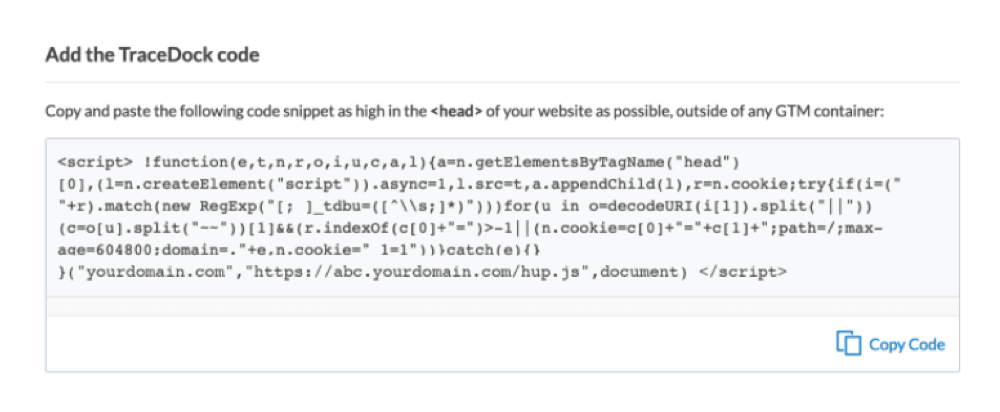Installation
Quick installation guide
Installing the webtracker on your website requires two technical steps, which are explained in this guide. You don't need any coding skills to follow and execute these steps.
Step 1: Adjust DNS records
To allow the webtracker to run on your website, you have to add an A Record to your
DNS configuration. You do this online, in the DNS settings of your hosting provider.
What is an A record?
An A record is a type of DNS record that maps your subdomain (alias) to an IP address. The implementation of the webtracker relies on A records to serve the webtracker code and to become a first-party user identification and data collection service.
When configuring the webtracker from the webtracker application, you will get instructions about which A record you have to add to your DNS settings:

Webtracker user portal: See which A record you have to add
The A record has to be added in the portal of your own domain host (e.g. GoDaddy).
Log in at your domain host, go to the DNS settings where you add the A record.
You have to take care of the following:
- Key is the subdomain that you receive.
- Type is A record.
- Value is the IP address that we provide.
- TTL ('Time to Live') decides for how long the record can be cached. We advise at least 1 hour.
After the A-record has been added, you have to go to TraceDock to check the status of the DNS configuration. You can do so by clicking the 'Check Status' button on the top right, like in the image below.
Once the status has been checked and we have confirmed that the A-record is properly implemented, the 'Check Status' button will dissapear and we can start generating the necessary SSL-certificates for the assigned subdomain.
It might take some time for the DNS configuration to be updated. This all depends on the TTL that was configured.

Tip: Do you want a different sub-domain?
We pre-selected a random subdomain from a list of 1000 most commonly used subdomains.
Tip: Are you using Cloudflare?
If you have Cloudflare enabled, you also need to adjust the Proxy Status of the endpoint in your Cloudflare dashboard so their caching is disabled. Adjusting your Cloudflare DNS settings to enable the webtracker can be done in the 3 simple steps.
Step 2: Install the webtracker code
To activate the webtracker on your website, add the code in the < head > section of your website, before
any Google Analytics or Tag Manager code. This snippet contains the JavaScript to activate the webtracker.
In the webtracker app, you will see the instructions about which code you have to paste:

Copy and paste the code into the < head > of your website
The snippet needs to be added to every page you want to track on your website.
We recommend you to add it to your website template to make sure the snippet is automatically added to every page of your website.
Updated about 1 year ago